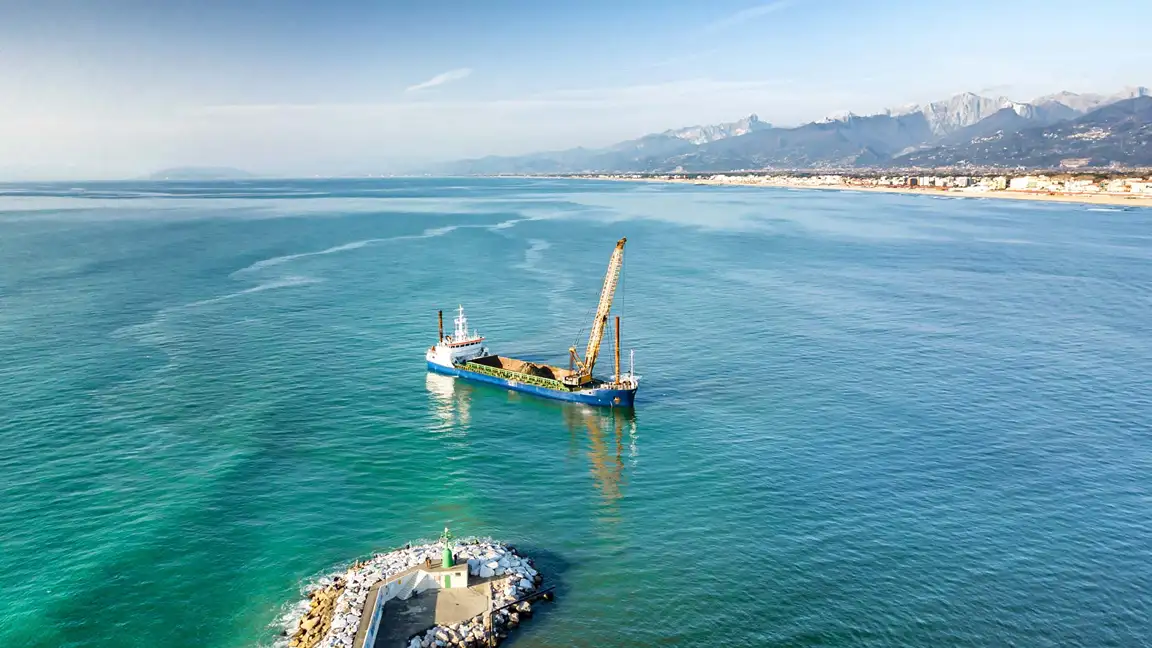The Problem with Shoaling at Montauk Inlet
The Montauk Inlet, located at the tip of Long Island, is a vital point of access for New York State’s commercial fishing fleet. Known as the largest fishing port in the state, Montauk Inlet serves as a bustling hub where fishing boats land tens of millions of dollars in seafood each year. However, recent concerns over the inlet’s shallow waters have prompted the U.S. Army Corps of Engineers to announce emergency dredging plans, which will help restore access and ensure the continued safety and success of the local fishing industry.
Shoaling is a natural process where sand, sediment, and debris accumulate in waterways, narrowing channels and making navigation difficult. At Montauk Inlet, this shoaling has become a major concern for commercial fishermen, as it severely reduces the depth of the inlet. Recent surveys have revealed sections of the waterway as shallow as 3.6 feet—much lower than what is safe for many fishing vessels.
Fishermen have repeatedly expressed frustration over the dangerous conditions. With vessels unable to safely navigate during low tide, boats have been forced to wait for hours for high tide to pass through. This has not only delayed their operations but also posed a safety risk, making it difficult for fishing boats to re-fuel and get back to sea. The situation is urgent, as the inlet’s shallow depths make it increasingly difficult for vessels to return home after long trips.
Economic Impact on Montauk’s Fishing Industry
The commercial fishing fleet in Montauk is facing severe challenges due to ongoing navigation issues at the inlet. As shoaling has made access difficult, boats have been unable to offload their catches in Montauk, leading to significant delays and revenue losses. Local business owners estimate a loss of around $100,000 due to these disruptions. Amanda Jones, director of operations at Inlet Seafood and co-owner of Jones Fisheries, explains that the shallow waters have made it nearly impossible for their boats to navigate safely. This problem affects the entire local economy, as some fishing vessels have been forced to offload their catches in Point Judith, Rhode Island, further complicating the situation.
Additionally, offloading fish outside New York poses a risk of reducing the state’s fishing quotas, potentially resulting in penalties. During peak season, approximately 500 boats pass through Montauk Inlet daily, contributing millions of dollars to the local economy. Without the ability to access the inlet, Montauk’s fishing industry faces long-term damage.
Local and Government Responses
In response to the crisis, local officials have quickly rallied to support the fishing community. U.S. Senate Minority Leader Chuck Schumer and U.S. Rep. Nick LaLota have urged the U.S. Army Corps of Engineers to prioritize emergency dredging at Montauk Inlet, emphasizing the safety concerns and economic losses caused by the shallow waters.
East Hampton Town Councilman David Lys also voiced his concerns, stating that multiple vessels have faced difficulties navigating the inlet in recent weeks. Lys and other officials are working alongside the Army Corps to ensure the emergency dredging process begins as soon as possible.
Suffolk County Executive Edward Romaine has further highlighted the urgency by requesting emergency funding to deepen the inlet’s channel to at least 17 feet, a crucial step to ensure safe passage for the larger vessels that rely on the port. The current depth of 12 feet is insufficient for many commercial boats, and Romaine’s call for swift action underscores the growing frustration with the delay in dredging.
The Emergency Dredging Plan
In response to these concerns, the U.S. Army Corps of Engineers has confirmed that emergency dredging will take place during the winter months of 2025. Approximately 10,000 cubic yards of sand will be removed from the inlet, primarily west of the west jetty, to restore safe navigation for fishing vessels. The Corps has stated that the project will have no adverse effects on endangered species, and they plan to follow all necessary environmental guidelines throughout the process.
Although the dredging is scheduled to begin soon, the work is contingent on the availability of funding and the possibility of a public hearing before construction begins. The Corps’ decision to proceed with this emergency work has been met with relief by Montauk’s fishing community, as it promises to restore safe access to the inlet.
The Bigger Picture: Supporting the Local Fishing Community
Montauk Inlet is more than just a local landmark—it’s the lifeblood of the fishing industry in the area. With hundreds of boats depending on it for daily access, ensuring that the inlet remains navigable is essential to the economic well-being of the community. If dredging efforts are successful, it will not only benefit the fishing industry but will also bolster the local economy by creating jobs and maintaining the flow of fresh seafood to markets.
The cooperation between local officials, fishermen, and the Army Corps of Engineers reflects the community’s commitment to ensuring the continued success of Montauk Inlet. As the dredging process moves forward, Montauk’s residents and business owners hope that this issue will be fully addressed, preserving the inlet for future generations.
Conclusion
The emergency dredging at Montauk Inlet is a crucial step toward resolving the severe navigation challenges facing the local fishing fleet. By removing accumulated sediment and restoring the channel’s depth, the U.S. Army Corps of Engineers is helping ensure that Montauk’s fishing industry can continue to thrive. Local officials and fishermen are hopeful that, with this work underway, the inlet will remain safe and accessible, allowing Montauk to maintain its status as New York’s premier fishing port for years to come.
